Abstract
During two 12-month periods, 12,395 accident and emergency department attenders with head injury were collected. Those characteristics which were significantly more common in head-injured patients who had skull fractures on X-ray were identified. These characteristics were: recent alcohol consumption in adults, initial unconsciousness, amnesia of any duration, vomiting, neurological signs, injuries sustained by pedestrians, motorcyclists and cyclists. Such characteristics were then further examined and their power as diagnostic tests for the presence of skull fracture on X-ray was detailed. In individual patients and especially in children, these characteristics were generally of little value in identifying patients with fractures. It was considered that, in the majority of individual patients with head injuries, accurate clinical diagnosis of radiologically apparent fractures was not possible. In view of this and in the light of the known risks in patients with fractures, it was concluded that skull X-rays should continue to be used relatively freely in the management of these patients.
Full text
PDF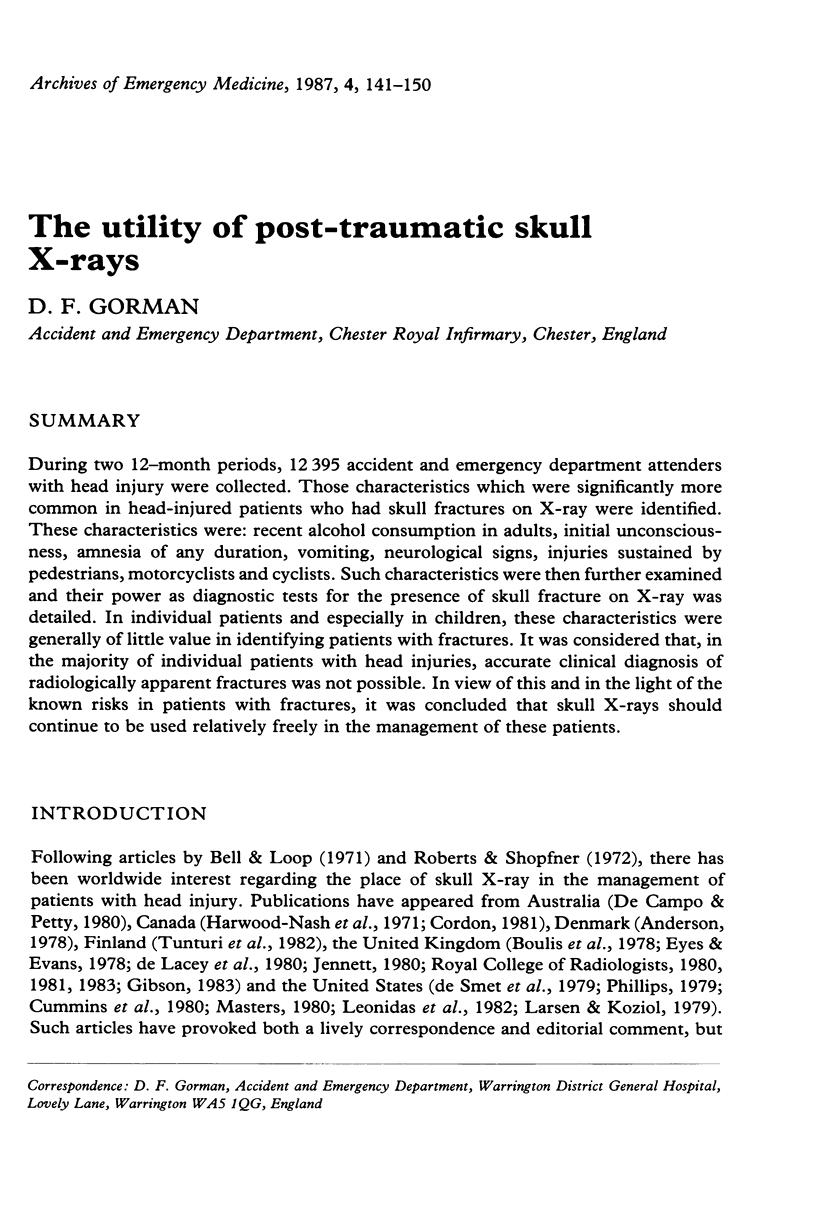
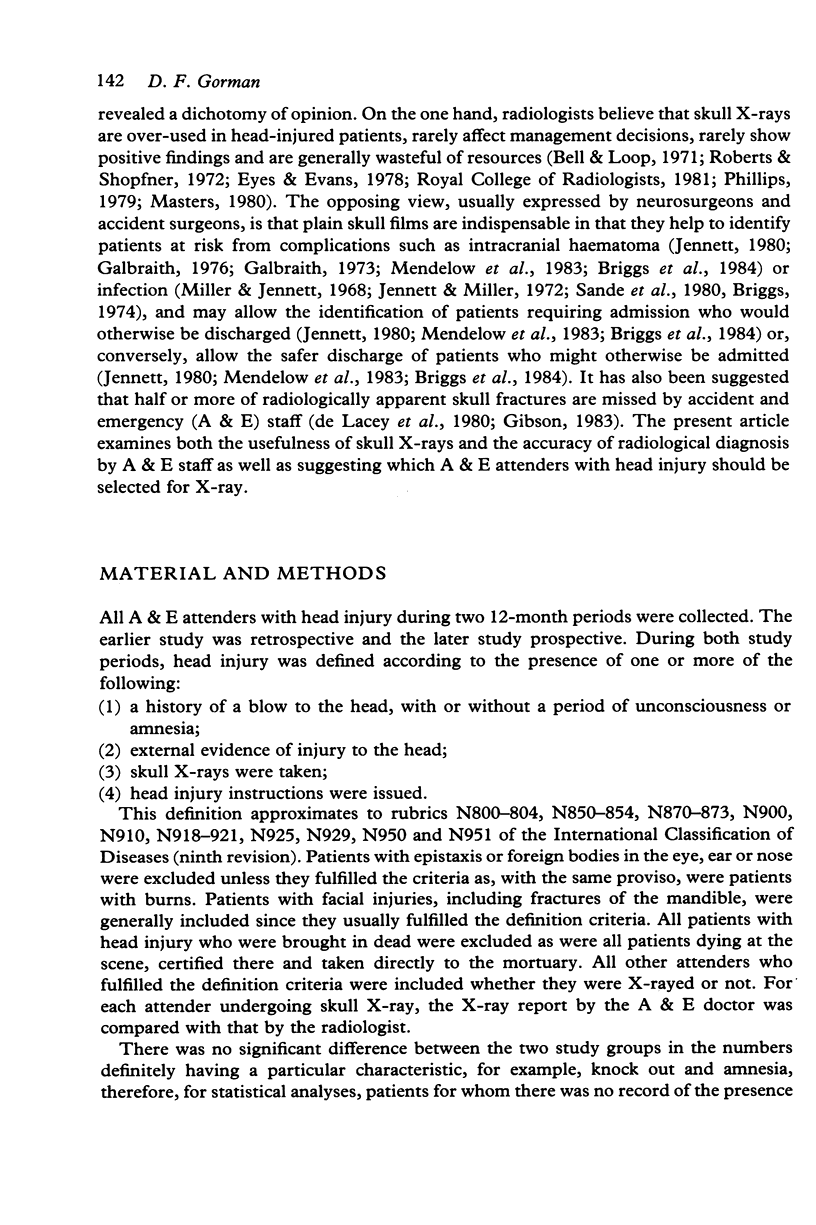
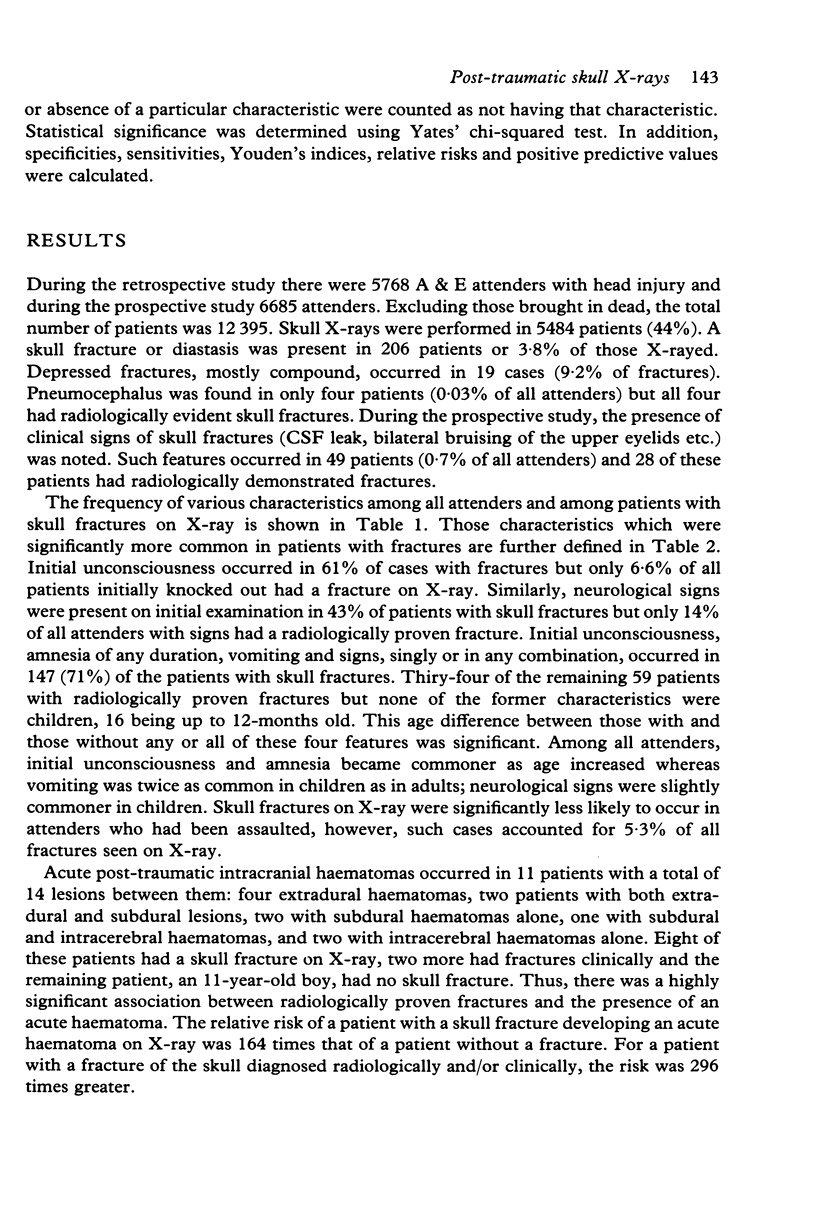
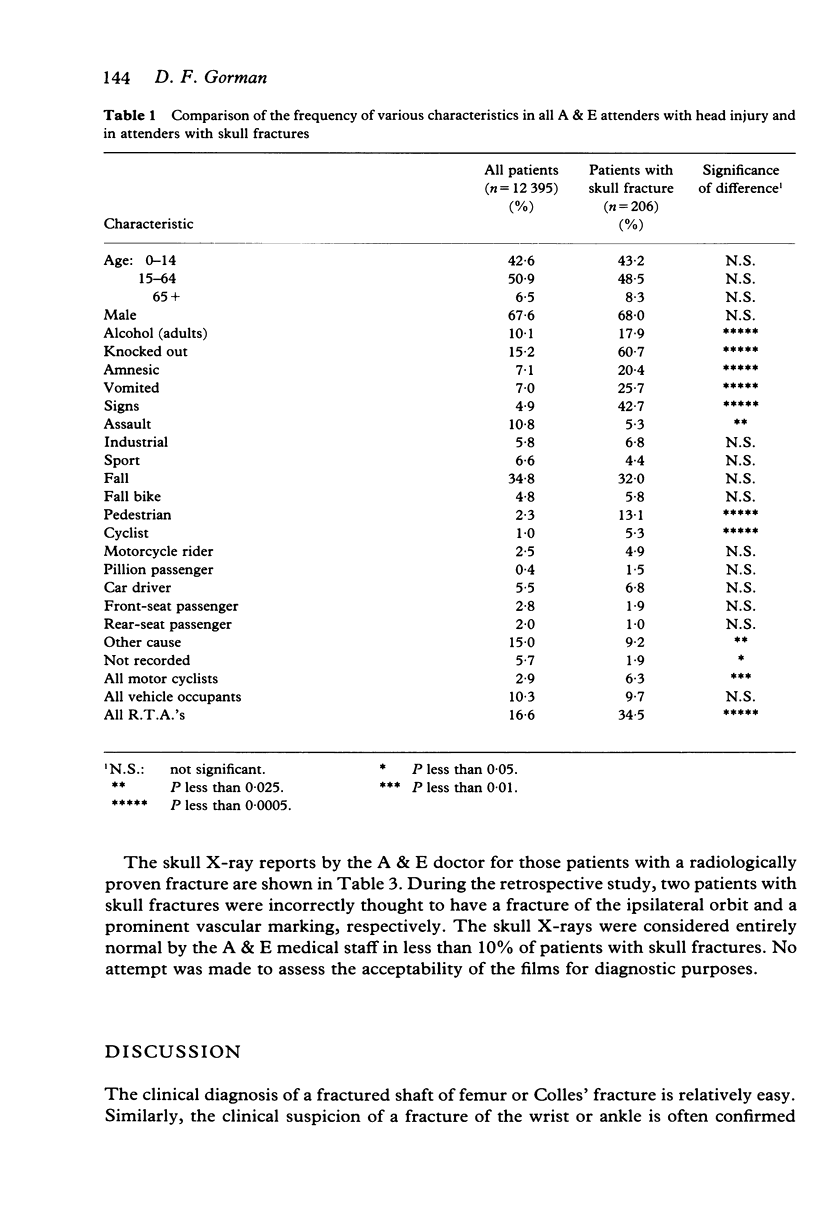
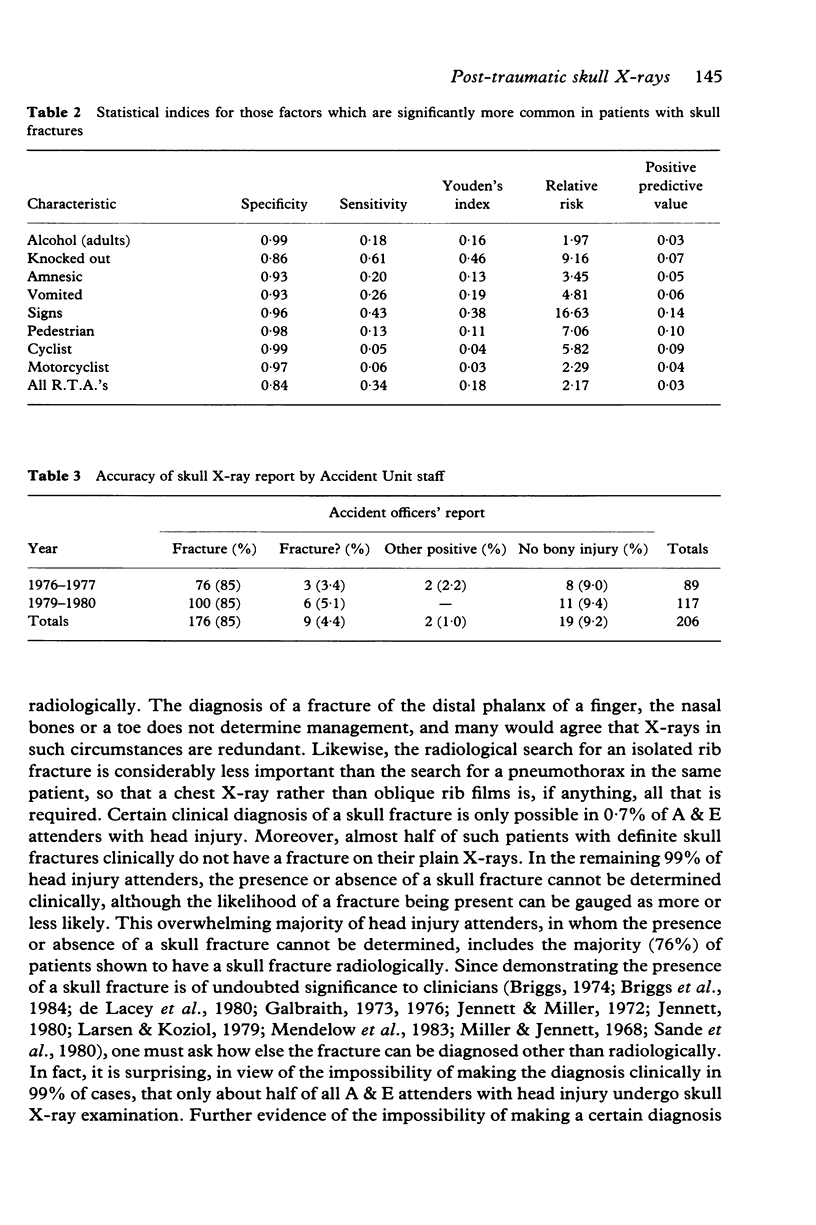
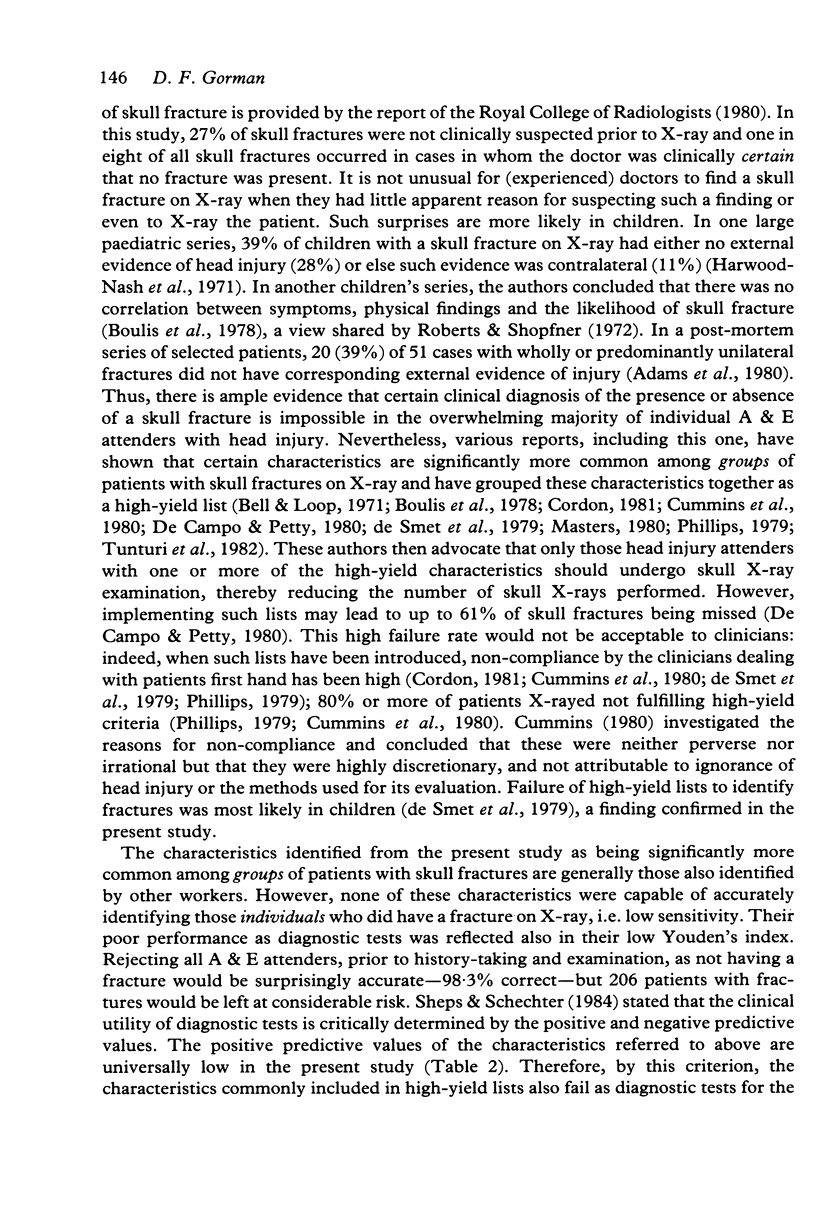
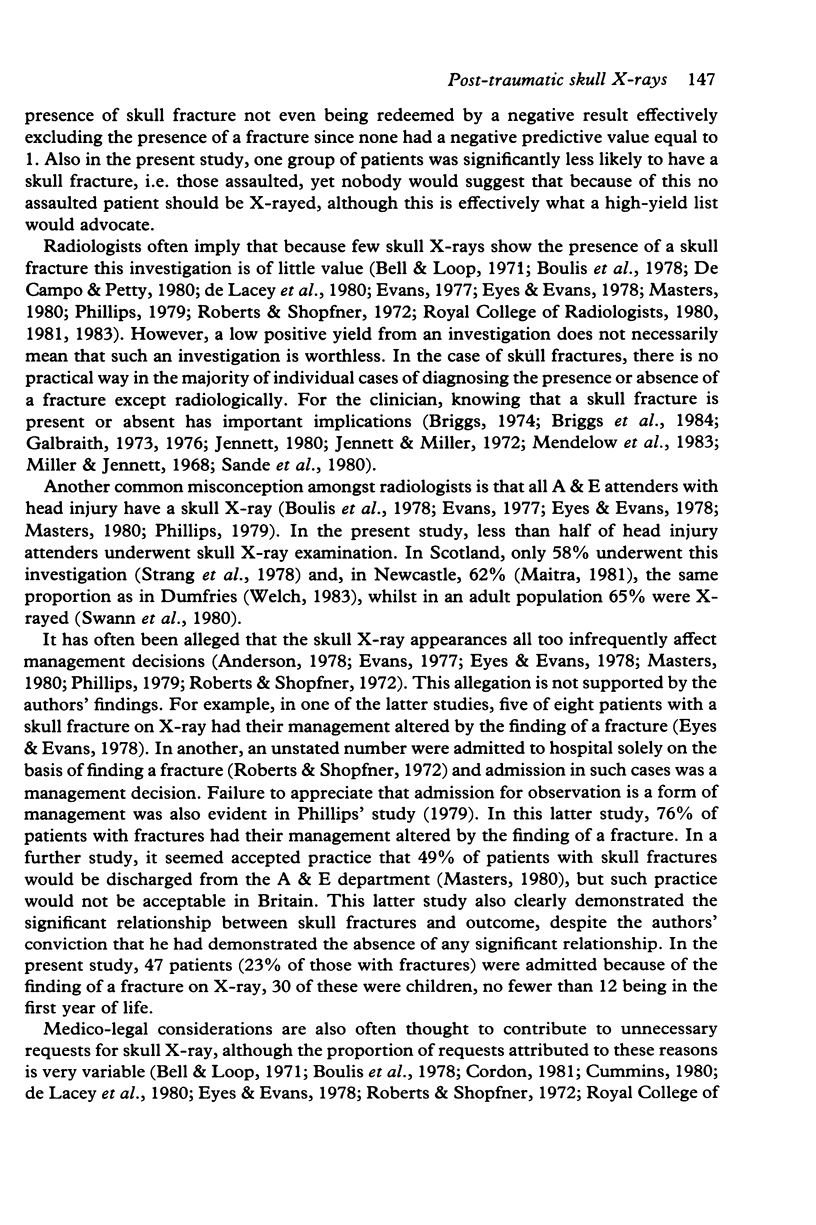
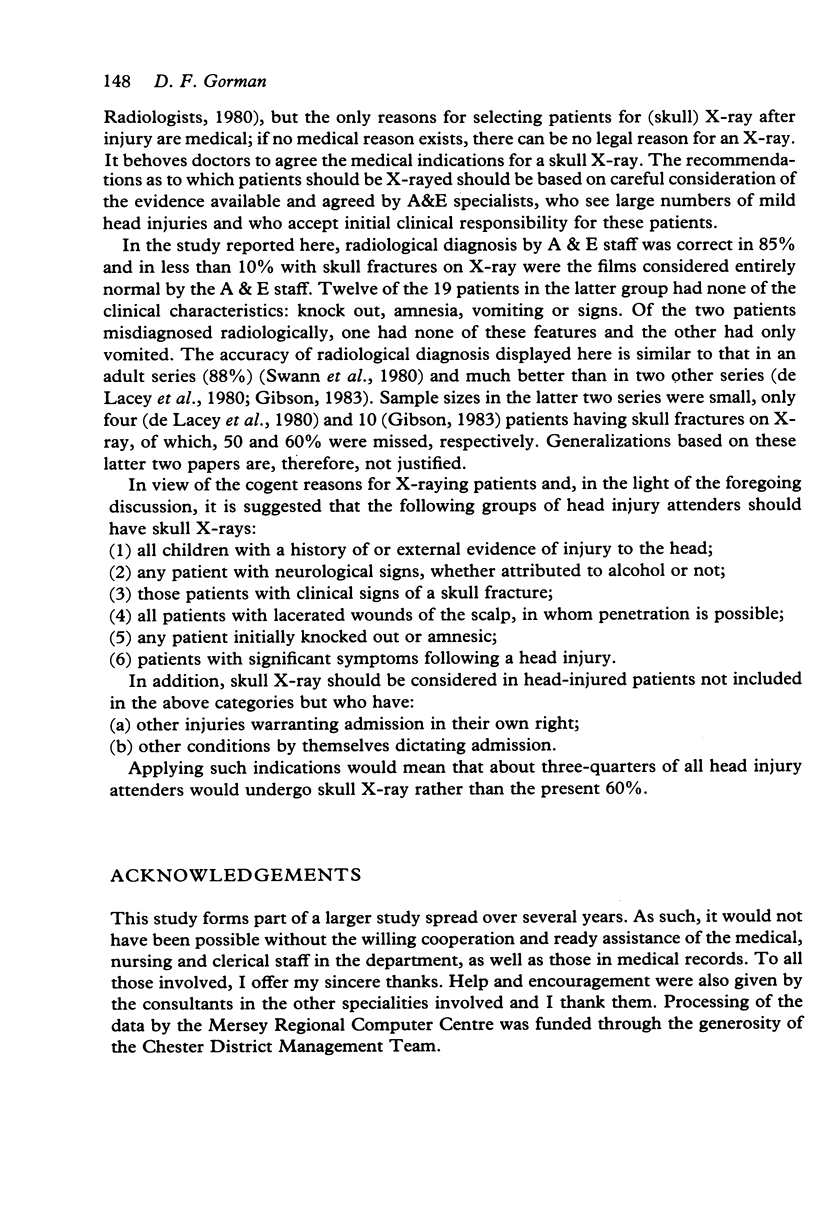
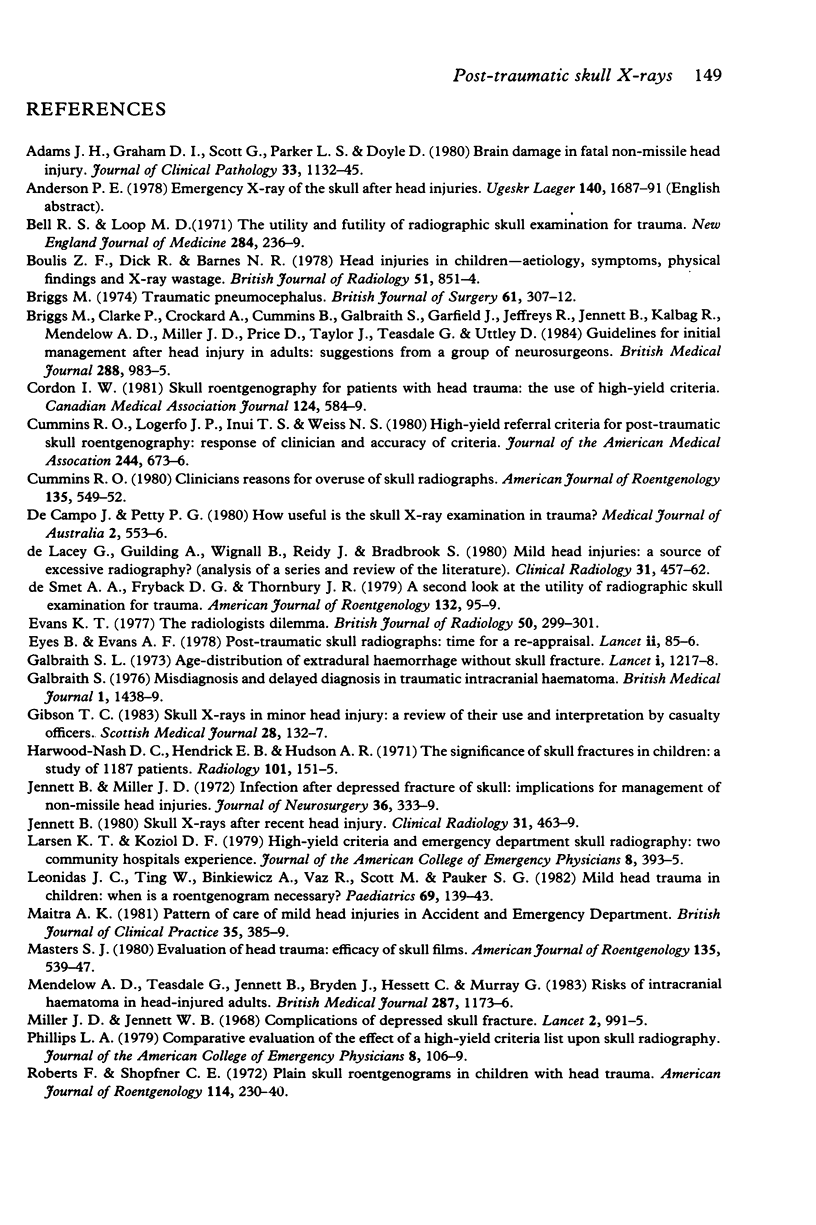
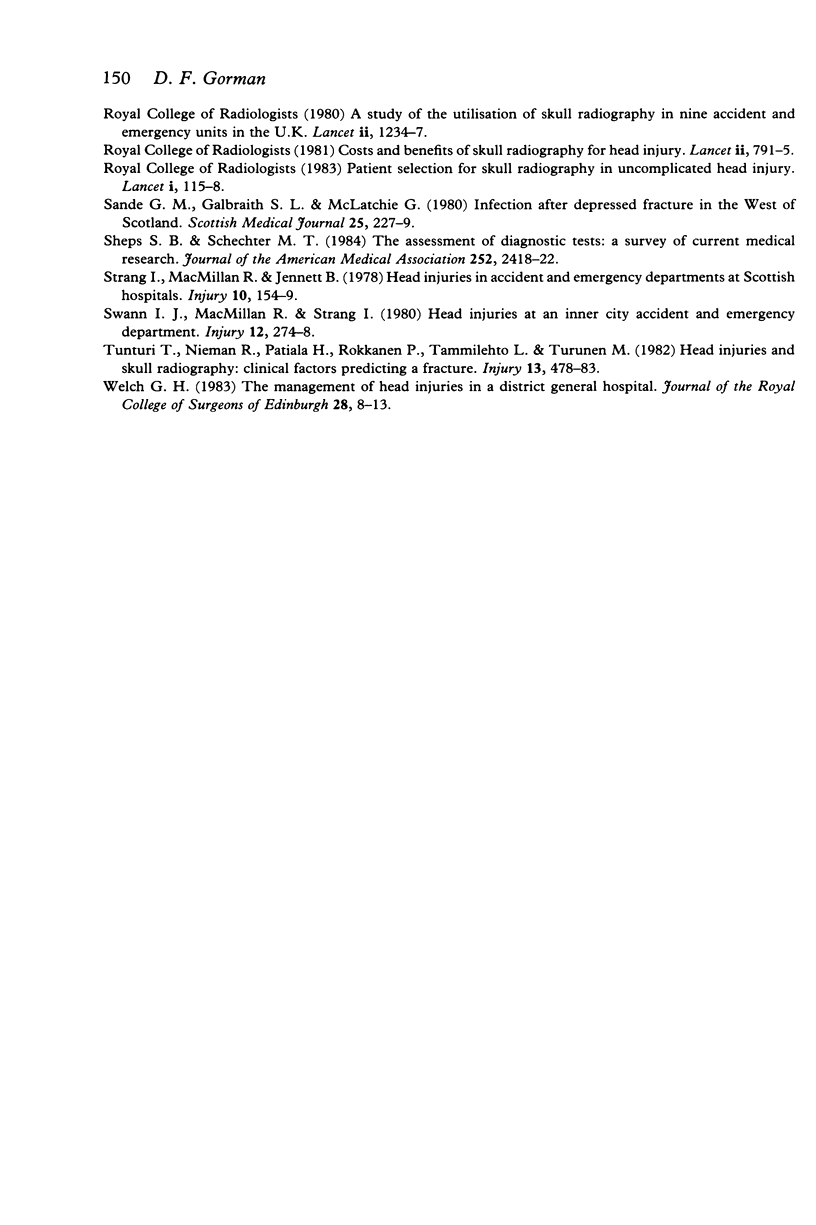
Selected References
These references are in PubMed. This may not be the complete list of references from this article.
- Adams J. H., Graham D. I., Scott G., Parker L. S., Doyle D. Brain damage in fatal non-missile head injury. J Clin Pathol. 1980 Dec;33(12):1132–1145. doi: 10.1136/jcp.33.12.1132. [DOI] [PMC free article] [PubMed] [Google Scholar]
- Andersen P. E., Jr Akut kranierøntgen ved hovedtraumer. Ugeskr Laeger. 1978 Jul 10;140(28):1687–1691. [PubMed] [Google Scholar]
- Bell R. S., Loop J. W. The utility and futility of radiographic skull examination for trauma. N Engl J Med. 1971 Feb 4;284(5):236–239. doi: 10.1056/NEJM197102042840504. [DOI] [PubMed] [Google Scholar]
- Boulis Z. F., Dick R., Barnes N. R. Head injuries in children--aetiology, symptoms, physical findings and x-ray wastage. Br J Radiol. 1978 Nov;51(611):851–854. doi: 10.1259/0007-1285-51-611-851. [DOI] [PubMed] [Google Scholar]
- Briggs M. Traumatic pneumocephalus. Br J Surg. 1974 Apr;61(4):307–312. doi: 10.1002/bjs.1800610415. [DOI] [PubMed] [Google Scholar]
- Cordon I. W. Skull roentgenography for patients with head trauma: the use of high-yield criteria. Can Med Assoc J. 1981 Mar 1;124(5):584–589. [PMC free article] [PubMed] [Google Scholar]
- Cummins R. O. Clinicians' reasons for overuse of skull radiographs. AJR Am J Roentgenol. 1980 Sep;135(3):549–552. doi: 10.2214/ajr.135.3.549. [DOI] [PubMed] [Google Scholar]
- Cummins R. O., LoGerfo J. P., Inui T. S., Weiss N. S. High-yield referral criteria for posttraumatic skull roentgenography. Response of physicians and accuracy of criteria. JAMA. 1980 Aug 15;244(7):673–676. [PubMed] [Google Scholar]
- DeSmet A. A., Fryback D. G., Thornbury J. R. A second look at the utility of radiographic skull examination for trauma. AJR Am J Roentgenol. 1979 Jan;132(1):95–99. doi: 10.2214/ajr.132.1.95. [DOI] [PubMed] [Google Scholar]
- Evans K. T. The radiologist's dilemma. Br J Radiol. 1977 May;50(593):299–301. doi: 10.1259/0007-1285-50-593-299. [DOI] [PubMed] [Google Scholar]
- Eyes B., Evans A. F. Post-traumatic skull radiographs. Time for a reappraisal. Lancet. 1978 Jul 8;2(8080):85–86. doi: 10.1016/s0140-6736(78)91395-8. [DOI] [PubMed] [Google Scholar]
- Galbraith S. L. Age-distribution of extradural haemorrhage without skull fracture. Lancet. 1973 Jun 2;1(7814):1217–1218. doi: 10.1016/s0140-6736(73)90529-1. [DOI] [PubMed] [Google Scholar]
- Galbraith S. Misdiagnosis and delayed diagnosis in traumatic intracranial haematoma. Br Med J. 1976 Jun 12;1(6023):1438–1439. doi: 10.1136/bmj.1.6023.1438. [DOI] [PMC free article] [PubMed] [Google Scholar]
- Gibson T. C. Skull X-rays in minor head injury. A review of their use and interpretation by casualty officers. Scott Med J. 1983 Apr;28(2):132–137. doi: 10.1177/003693308302800207. [DOI] [PubMed] [Google Scholar]
- Guidelines for initial management after head injury in adults. Suggestions from a group of neurosurgeons. Br Med J (Clin Res Ed) 1984 Mar 31;288(6422):983–985. doi: 10.1136/bmj.288.6422.983. [DOI] [PMC free article] [PubMed] [Google Scholar]
- Harwood-Nash D. C., Hendrick E. B., Hudson A. R. The significance of skull fractures in children. A study of 1,187 patients. Radiology. 1971 Oct;101(1):151–156. doi: 10.1148/101.1.151. [DOI] [PubMed] [Google Scholar]
- Jennett B., Miller J. D. Infection after depressed fracture of skull. Implications for management of nonmissile injuries. J Neurosurg. 1972 Mar;36(3):333–339. doi: 10.3171/jns.1972.36.3.0333. [DOI] [PubMed] [Google Scholar]
- Jennett B. Skull X-rays after recent head injury. Clin Radiol. 1980 Jul;31(4):463–469. doi: 10.1016/s0009-9260(80)80195-4. [DOI] [PubMed] [Google Scholar]
- Larsen K. T., Jr, Koziol D. F. High yield criteria and emergency department skull radiography: two community hospitals' experience. JACEP. 1979 Oct;8(10):393–395. doi: 10.1016/s0361-1124(79)80402-5. [DOI] [PubMed] [Google Scholar]
- Leonidas J. C., Ting W., Binkiewicz A., Vaz R., Scott R. M., Pauker S. G. Mild head trauma in children: When is a roentgenogram Necessary. Pediatrics. 1982 Feb;69(2):139–143. [PubMed] [Google Scholar]
- Maitra A. K. Pattern of care for mild head injuries in accident and emergency department. Br J Clin Pract. 1981 Nov-Dec;35(11-12):385–389. [PubMed] [Google Scholar]
- Masters S. J. Evaluation of head trauma: efficacy of skull films. AJR Am J Roentgenol. 1980 Sep;135(3):539–547. doi: 10.2214/ajr.135.3.539. [DOI] [PubMed] [Google Scholar]
- Mendelow A. D., Teasdale G., Jennett B., Bryden J., Hessett C., Murray G. Risks of intracranial haematoma in head injured adults. Br Med J (Clin Res Ed) 1983 Oct 22;287(6400):1173–1176. doi: 10.1136/bmj.287.6400.1173. [DOI] [PMC free article] [PubMed] [Google Scholar]
- Miller J. D., Jennett W. B. Complications of depressed skull fracture. Lancet. 1968 Nov 9;2(7576):991–995. doi: 10.1016/s0140-6736(68)91293-2. [DOI] [PubMed] [Google Scholar]
- Phillips L. A. Comparative evaluation of the effect of a high yield criteria list upon skull radiography. JACEP. 1979 Mar;8(3):106–109. doi: 10.1016/s0361-1124(79)80152-5. [DOI] [PubMed] [Google Scholar]
- Roberts F., Shopfner C. E. Plain skull roentgenograms in children with head trauma. Am J Roentgenol Radium Ther Nucl Med. 1972 Feb;114(2):230–240. doi: 10.2214/ajr.114.2.230. [DOI] [PubMed] [Google Scholar]
- Sande G. M., Galbraith S. L., McLatchie G. Infection after depressed fracture in the west of Scotland. Scott Med J. 1980 Jul;25(3):227–229. doi: 10.1177/003693308002500308. [DOI] [PubMed] [Google Scholar]
- Sheps S. B., Schechter M. T. The assessment of diagnostic tests. A survey of current medical research. JAMA. 1984 Nov 2;252(17):2418–2422. [PubMed] [Google Scholar]
- Strang I., MacMillan R., Jennett B. Head injuries in accident and emergency departments at Scottish hospitals. Injury. 1978 Nov;10(2):154–159. doi: 10.1016/s0020-1383(79)80084-4. [DOI] [PubMed] [Google Scholar]
- Swann I. J., MacMillan R., Strong I. Head injuries at an inner city accident and emergency department. Injury. 1981 Jan;12(4):274–278. doi: 10.1016/0020-1383(81)90200-x. [DOI] [PubMed] [Google Scholar]
- Tunturi T., Nieminen R., Pätiälä H., Rokkanen P., Tammilehto L., Turunen M., Lehtinen E., Seppänen S. Head injuries and skull radiography: clinical factors predicting a fracture. Injury. 1982 May;13(6):478–483. doi: 10.1016/0020-1383(82)90162-0. [DOI] [PubMed] [Google Scholar]
- Welch G. H. The management of head injuries in a district general hospital. J R Coll Surg Edinb. 1983 Jan;28(1):8–13. [PubMed] [Google Scholar]
- de Campo J., Petty P. G. How useful is the skull x-ray examination in trauma? Med J Aust. 1980 Nov 15;2(10):553–555. doi: 10.5694/j.1326-5377.1980.tb100765.x. [DOI] [PubMed] [Google Scholar]
- de Lacey G., Guilding A., Wignall B., Reidy J., Bradbrook S. Mild head injuries: a source of excessive radiography? (analysis of a series and review of the literature). Clin Radiol. 1980 Jul;31(4):457–462. doi: 10.1016/s0009-9260(80)80194-2. [DOI] [PubMed] [Google Scholar]


